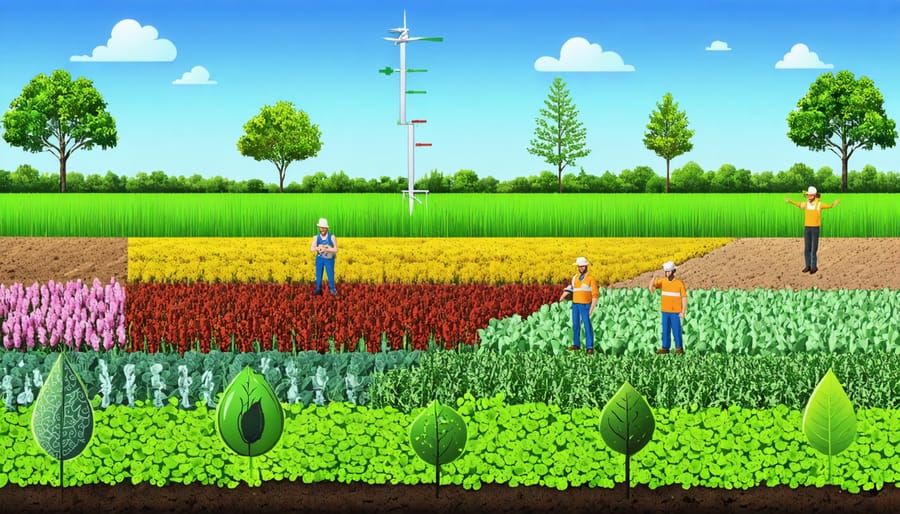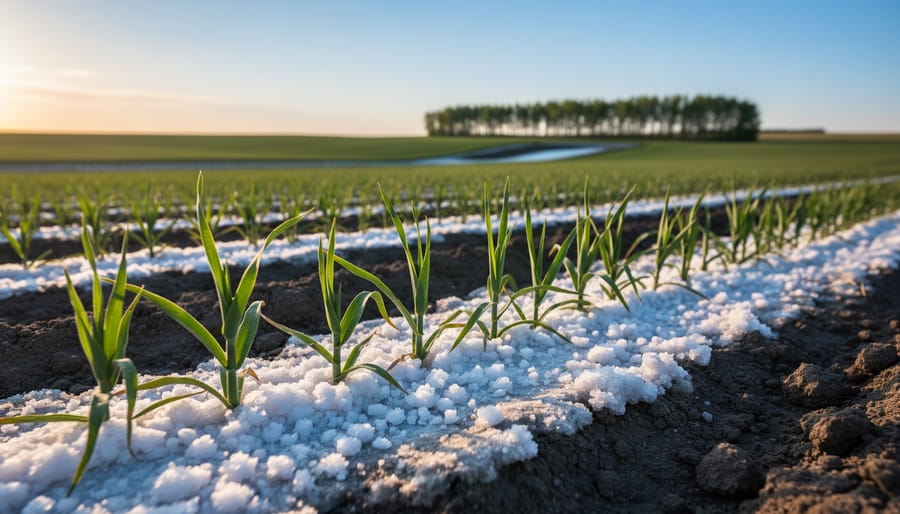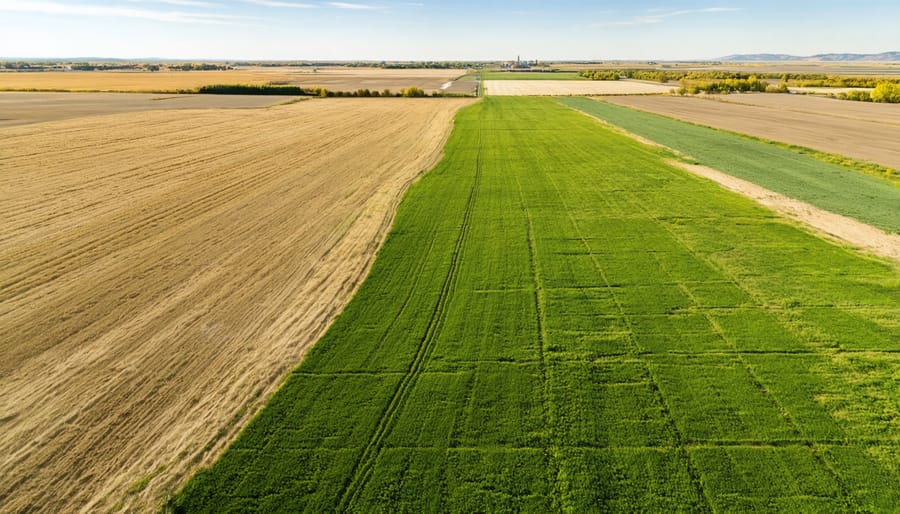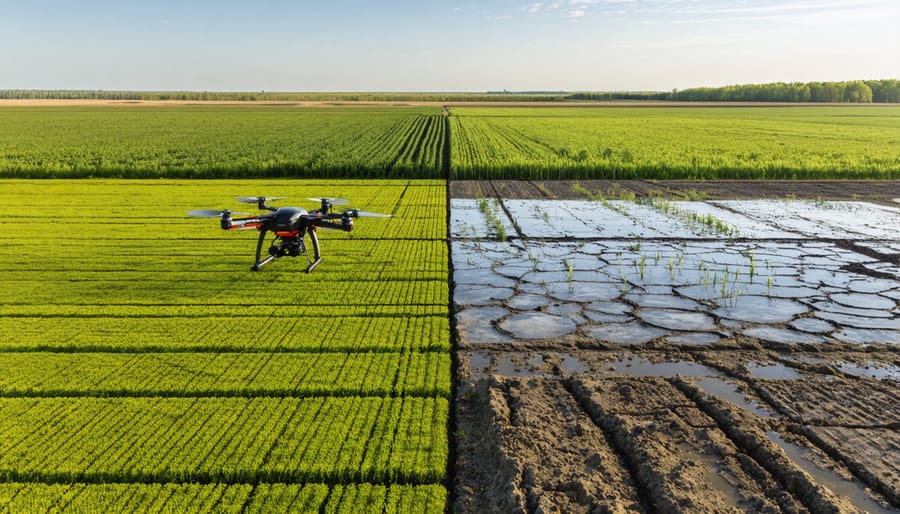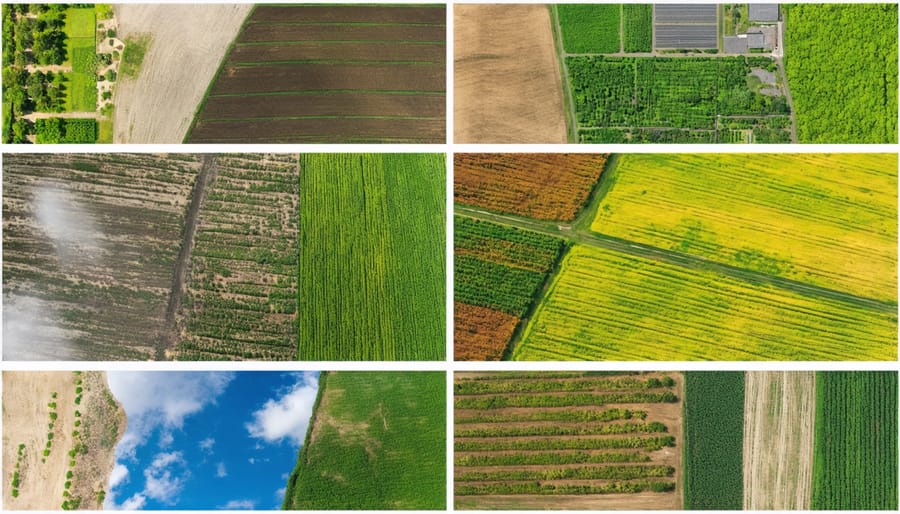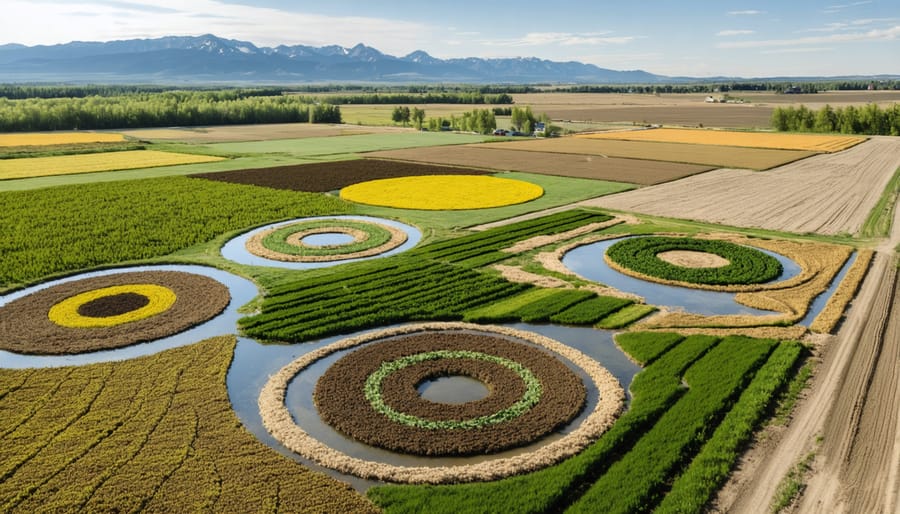Monitor soil nutrient levels through annual testing in early spring before seeding to establish precise fertilizer requirements across your Alberta farmland. Implement vital soil health practices by balancing nitrogen, phosphorus, and potassium ratios based on crop-specific needs and local soil conditions. Apply micronutrients strategically during key growth stages, particularly zinc and copper in Alberta’s calcareous soils, to maximize yield potential and crop quality. Rotate diverse cover crops to naturally replenish soil nutrients, prevent erosion, and build organic matter content while reducing dependence on synthetic fertilizers.
Managing soil nutrients effectively stands as the cornerstone of successful agriculture in Alberta’s diverse growing regions. From the rich Black Chernozemic soils of central Alberta to the Brown soils of the southeast, proper nutrient management not only ensures optimal crop yields but also promotes long-term soil health and farm sustainability. Recent soil analysis data from Alberta Agriculture shows that farms implementing comprehensive nutrient management strategies consistently achieve 15-20% higher yields while reducing fertilizer costs by up to 30%.
Understanding Alberta’s Soil Profile
Regional Soil Variations
Alberta’s diverse landscape features distinct soil zones that require tailored nutrient management approaches. The Black soil zone, predominantly found in central Alberta around Edmonton and Red Deer, offers naturally fertile soil rich in organic matter, perfect for growing cereals and oilseeds. Moving north, the Dark Gray and Gray Wooded zones present unique challenges, with lower organic matter content requiring careful nutrient supplementation.
Southern Alberta’s Brown and Dark Brown soil zones, stretching from Medicine Hat to Lethbridge, typically have lower moisture retention and require specific attention to timing of nutrient applications. These regions often benefit from split application strategies to maximize nutrient uptake during critical growing periods.
The Peace Region in northwestern Alberta features unique soil compositions influenced by glacial deposits, resulting in variable fertility levels across relatively short distances. Local farmers have found success with precision agriculture techniques that account for these variations.
Each region’s soil characteristics are further influenced by local weather patterns, topography, and historical land use, making regular soil testing essential for developing effective nutrient management strategies.

Key Nutrient Challenges
Alberta’s soils commonly face several key nutrient challenges that farmers need to address for optimal crop production. Nitrogen deficiency is particularly prevalent in our prairie soils, especially in areas with high organic matter content but limited moisture. Many farmers report seeing yellowing leaves and stunted growth in their crops when nitrogen levels are insufficient.
Phosphorus deficiency is another significant concern, particularly in calcareous soils common throughout central and southern Alberta. This challenge often manifests as purple-tinted leaves and delayed crop maturity. Sulfur deficiency, especially in Gray Wooded soil zones, can severely impact canola yields and quality.
Micronutrient deficiencies, particularly zinc and copper, are becoming more common as intensive farming practices continue. In the Peace Region and parts of central Alberta, boron deficiency can affect alfalfa and canola production. Iron chlorosis, showing up as yellowing between leaf veins, frequently occurs in areas with high-pH soils.
Understanding these regional nutrient challenges helps farmers develop targeted solutions for their specific soil conditions, leading to more efficient fertilizer use and better crop yields.
Essential Soil Testing Practices

When and How to Test
The best time to test your soil in Alberta is either early spring, before seeding, or fall after harvest – typically between September and November. Fall testing is particularly advantageous as it gives you time to plan and adjust your nutrient strategy for the upcoming growing season.
To collect reliable samples, divide your field into management zones based on soil type, topography, and previous crop performance. For each zone, take 15-20 core samples at a depth of 0-15 cm for most nutrients, and additional samples at 15-30 cm and 30-60 cm for nitrogen and sulphur testing. Mix these samples thoroughly in a clean plastic bucket.
“I always recommend farmers walk their fields in a zigzag pattern when collecting samples,” says Sarah Thompson, soil specialist at the Lethbridge Research Centre. “This ensures we get a truly representative sample of the field.”
Avoid sampling when soil conditions are extremely wet or within six weeks of fertilizer application. Keep samples cool and deliver them to an accredited lab within 24 hours. If immediate delivery isn’t possible, air-dry the samples at room temperature.
For most Alberta farms, annual testing is recommended, though problem areas may need more frequent monitoring. Remember to maintain detailed records of your sampling locations using GPS coordinates or field markers – this helps track changes in soil fertility over time and makes future sampling more consistent.
Reading Your Results
Reading your soil test report shouldn’t feel like decoding a secret message. Let’s break down the key elements you’ll encounter and how to use them to make smart decisions for your farm.
First, look at your pH levels – they typically range from 5.5 to 8.0 in Alberta soils. A pH between 6.0 and 7.0 is ideal for most crops, as it allows for optimal nutrient availability. Next, focus on your macronutrients: nitrogen (N), phosphorus (P), and potassium (K). These are usually reported in parts per million (ppm) or kilograms per hectare (kg/ha).
Pay special attention to your organic matter percentage – anything above 3% is considered good for our prairie soils. This number tells you about your soil’s ability to retain nutrients and water. When reviewing micronutrient levels, remember that deficiencies in zinc and copper are common in Alberta, particularly in calcareous soils.
Don’t get overwhelmed by the numbers. Instead, compare them to the optimal ranges provided in your report for your specific crop plans. Many local agronomists recommend maintaining detailed records of your soil tests over time, allowing you to track changes and spot trends in your soil’s health.
If certain values seem concerning, consider consulting with your local agricultural extension office. They can help interpret the results and suggest appropriate amendments based on your specific situation and goals.
Sustainable Nutrient Application Strategies
Organic Matter Management
Effective organic matter management is crucial for maintaining healthy, productive soils in Alberta’s diverse agricultural landscape. Composting and crop residue management are two fundamental practices that can significantly enhance soil fertility and structure.
Composting transforms farm waste into valuable nutrients, with properly managed compost piles reaching temperatures between 55-65°C to eliminate weed seeds and pathogens. For best results, maintain a carbon-to-nitrogen ratio of 30:1 and moisture content around 50%. Many Alberta farmers successfully integrate on-farm composting by collecting livestock manure, crop residues, and other organic materials throughout the growing season.
Crop residue management involves strategically leaving plant materials on fields after harvest. This practice helps prevent soil erosion, particularly during our strong prairie winds, while gradually releasing nutrients back into the soil. Aim to maintain at least 30% ground cover through winter months for optimal soil protection.
Consider these practical steps for implementation:
– Establish dedicated composting areas away from water sources
– Monitor compost temperature and moisture regularly
– Use cover crops to supplement residue coverage
– Incorporate residues shallow ly to maintain soil structure
– Test your soil annually to track organic matter improvements
By implementing these practices, many Alberta farmers have reported improved water retention, reduced fertilizer needs, and better crop yields over time.
Precision Fertilizer Application
Modern precision fertilizer application has revolutionized how Alberta farmers manage soil nutrients. Using GPS-guided equipment and variable rate technology (VRT), farmers can now apply fertilizers with pinpoint accuracy, reducing waste and maximizing crop uptake.
Zone-based application has become increasingly popular across the prairies, where farmers divide their fields into management zones based on soil testing results, yield maps, and topography. This approach allows for customized nutrient application rates that match specific soil conditions within each zone.
Smart sensors and real-time monitoring systems help farmers track nitrogen levels, moisture content, and other key indicators throughout the growing season. These tools enable quick adjustments to fertilizer programs, ensuring crops receive optimal nutrition when they need it most.
Many Alberta farmers are combining precision technology with split application methods, applying smaller amounts of fertilizer multiple times during the growing season rather than one large application. This strategy has shown to improve nutrient use efficiency and reduce the risk of nutrient loss through leaching or runoff.
For example, Dennis Weber, a farmer near Leduc, reported a 15% reduction in fertilizer costs while maintaining yields after implementing precision application methods on his canola fields. Similar success stories are emerging across the province as more farmers adopt these technologies.
To get started with precision application, consider working with local agronomists who can help develop zone maps and application prescriptions tailored to your specific field conditions.

Cover Cropping Benefits
Cover crops are a game-changer for Alberta farmers looking to enhance their soil’s nutritional profile naturally. These crops, planted during off-seasons when fields would typically lie bare, serve multiple purposes in maintaining and improving soil health.
In our prairie climate, popular cover crop options include legumes like field peas and red clover, which excel at fixing nitrogen from the air into the soil. Cereal rye and oats are excellent choices for preventing erosion and adding organic matter, particularly important during our windy seasons.
The benefits of cover cropping extend beyond basic soil protection. These plants create extensive root systems that improve soil structure and water retention capacity. Their organic matter contribution increases the soil’s ability to hold essential nutrients, reducing the need for synthetic fertilizers. Many Alberta farmers report up to 25% reduction in fertilizer costs after implementing cover crop systems.
Local success stories demonstrate the effectiveness of this practice. For instance, farms near Lethbridge have documented significant improvements in soil organic matter, with increases of 1-2% over three years of consistent cover cropping. These improvements translate to better water infiltration and reduced soil compaction.
To maximize benefits, timing is crucial. For best results in our climate, plant winter-hardy varieties like fall rye in late August or early September. This ensures adequate growth before winter while protecting the soil during spring thaw.
Remember, cover crops are an investment in your soil’s long-term health and productivity.
Success Stories from Alberta Farms
Case Study: Central Alberta Grain Farm
The Thompson family farm, located 30 kilometers east of Red Deer, transformed their 2,000-hectare grain operation through strategic nutrient management. After struggling with declining yields in 2018, they partnered with local soil specialists to develop a comprehensive fertility plan focused on building healthy soil communities.
Their approach began with intensive soil testing across different field zones, revealing significant variations in nitrogen and phosphorus levels. The Thompsons implemented variable-rate fertilizer application, using GPS-guided equipment to precisely deliver nutrients where needed. They also introduced cover crops, including fall rye and field peas, to improve soil structure and nutrient cycling.
The results were remarkable. Within three years, their wheat yields increased by 15%, while fertilizer costs decreased by 20%. Soil organic matter improved from 2.8% to 3.5%, enhancing water retention and reducing erosion. The farm’s success has inspired neighboring operations to adopt similar practices, creating a local network of farmers sharing soil management experiences and solutions.
Today, the Thompson farm serves as a demonstration site for sustainable nutrient management practices in Central Alberta, proving that precision agriculture can benefit both the environment and the bottom line.
Expert Interview: Local Soil Specialist
“In my 25 years of analyzing Alberta soils, I’ve seen dramatic improvements in soil health when farmers take a systematic approach to nutrient management,” says Dr. Sarah Thompson, senior soil specialist at the Agricultural Research Centre in Lethbridge.
Dr. Thompson emphasizes the importance of regular soil testing, particularly in early spring and late fall. “Our Prairie soils are unique. What works in Ontario or B.C. won’t necessarily work here. I recommend testing every two to three years at minimum, focusing on phosphorus and nitrogen levels, which are often limiting factors in our region.”
She notes a growing trend among successful Alberta farmers: “More producers are incorporating cover crops and reducing tillage. One farmer I work with in Red Deer saw his organic matter increase by 2% over five years using this approach, leading to better water retention and nutrient availability.”
Her top advice? “Start with a baseline soil test, understand your crop rotation needs, and don’t forget about micronutrients. They’re often overlooked but crucial for optimal yield.”
Effective soil nutrient management is a cornerstone of successful farming in Alberta, and by implementing the strategies we’ve discussed, you can significantly improve your soil health and crop yields. Remember that soil testing should become a regular part of your farming routine, ideally conducted every 1-2 years to track changes and adjust your management approach accordingly.
Start small by focusing on one or two key areas of improvement, such as optimizing your fertilizer application timing or introducing cover crops into your rotation. As you gain confidence and see results, gradually expand your nutrient management program. Connect with local agricultural extension services and fellow farmers who have successfully implemented similar practices – their experiences can provide valuable insights for your journey.
Keep detailed records of your soil tests, amendments, and crop responses. This data will become invaluable as you fine-tune your approach over the seasons. Don’t forget to consider the economic aspects of your nutrient management decisions, balancing input costs with potential yield improvements.
By taking a holistic approach to soil nutrient management, you’re not just investing in next season’s crop – you’re building a resilient and sustainable farming operation for future generations. Remember that soil health is a long-term commitment, and small, consistent improvements will lead to significant benefits over time. Stay informed about new research and technologies in soil management, and remain flexible in adapting your practices as conditions change.

